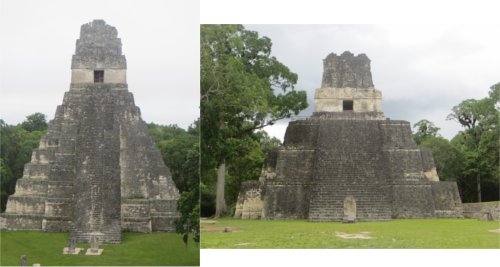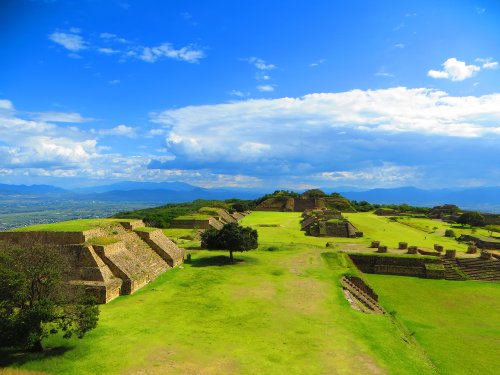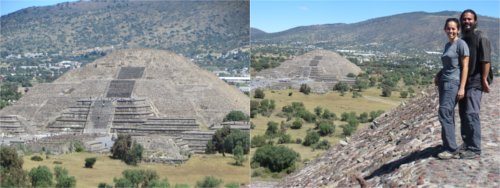Mesoamerican Heritage and Culture
During our months of travels in Central America and Mexico we had the opportunity to visit different archaeological sites and learn about the Mesoamerican indigenous heritage and culture. We were impressed by many recurrent and interesting features of these groups and although writing an article to summarize them all is not our ambition, we really feel we must attempt to put together some words and images of what we discovered. Our months of travels through this region taught us how wise, developed, and interesting our ancestors’ way of life was and how proud we should be of our indigenous roots. The following observations and pictures represent what we learned at many different sites we visited in Honduras, El Salvador, Guatemala, and Mexico.


The Mayans have a language with a hieroglyphic writing system that arose in the fourth century BC. It was characterized by the use of image or hieroglyphs to represent words, syllables, or vowels with some aesthetic variants. They also had a numeric system, and a sun and moon calendar. All these characteristics proved the advances of this civilization. Most Mayan original written texts did not survive the Spanish colonization, but three post-classic specimens have been preserved and they are now in Dresden, Madrid, and Paris. The Popol Vuh, a book from the XVI century, preserves the ancestral stories and knowledge of the Mayans.
A mythological god that is found in all Mesoamerican groups is Quetzalcoatl, the “feathered serpent.” This symbolic name represents the powerful serpent with the beautiful feathers of the quetzal. This feathered snake has origins of a secret element from the pre-classic period, and it was especially important for the Mayas, Teotihuacans, Tulas, and Aztecs. In general, we admired the important role and value the native group of Mesoamerica gave to animals, which were represented constantly in their temples as divinity figures full of meaning and power over their existence. Today, the most powerful and practiced religions in the world are sadly so detached from nature, animals, and the natural order of life on earth.
Chac-Mool is another common figure represented in many groups of Mesoamerica. Chac-Mool is a messenger or intermediary between man and gods. It was in charge of taking the offerings placed over its abdominal cavity to the gods.
The colors, magnificent structures, and sculptures of the Mesoamericans groups are another common element which proved their advances in construction and art, simply amazing!


The Ceiba tree acted as a connector between the different levels of existence for the Mayans. The Cosmovision of the indigenous groups of Mesoamerica is clearly manifested in their burials, full of offerings and meaningful objects for the trip to the afterlife. The place and significance of death in the Mesoamerican cultures was clearly represented and central to their way of living.
Another common practice we noticed amongst Mesoamerican groups was the cranial deformation, mutilation, and dental inlays for the people within the highest social power. The importance of having a different and specific appearance to earn a social status appeared to be a human trend. We noticed a similar dynamic in historical issues related with race, in which a world where power, value, and positive attributes are given to humans with white skin and in which your way of dressing is attached to your status.

Ballcourts were conceived as entrances to the underworld, places of death but also of resurrection. In Mayan mythology, the celestial bodies were thought to descend at dusk to the underworld, the region of skeletal beings where they fought and vanquished the forces of darkness. Every morning they were reborn, guaranteeing the continuity of earthly life. The ballgame represented the cyclical regeneration of life through death, a performance in which the ball symbolized the movement of the planets and stars. Just as corncobs were cut from the stalks, the defeated players were beheaded, a final dramatic act that reiterated the link between this ritualistic game and the fertility of the earth. The game was also related to war because the sacrificial victims tended to be captives from enemy cities.
Sacrifice for the Mexica, or Aztecs, represented the incursion of men into divinity. The individual chosen to be sacrificed represents the fair retribution to the gods’ sacrifices to create the fifth sun. To die through a sacrifice gave the victim the greatest honor after death: to join the sun during his daily route to light the Earth.
The importance of war during the post-classic period was strongly represented by the leadership of the Aztecs in what is today Mexico City. The decline of the indigenous empires caused by their internal conflicts was an opportunity taken by the new Spanish colonizers. The arrival of the Spanish colony represented by Hernan Cortes marked the beginning of another cycle of oppression. In the beginning of the XVII century, the Catholic Church of New Spain (Mexico and Central America today) was interested in indoctrinating the adoration of the souls in the purgatory, a task that became very easy because the indigenous had rituals to honor their deaths since before the Hispanics arrived. The amalgamation between the Mesoamerican indigenous beliefs and the Catholic beliefs is clearly seen in many of the day-to-day religious practices in Central America and Mexico today.
Most important of all, a big part of the Mesoamerican indigenous heritage is still alive today within the lifestyle of local people in this region. Do not miss your chance to experience it and learn from them. Below you can find pictures of the ancient wonders that were left by these amazing people.









